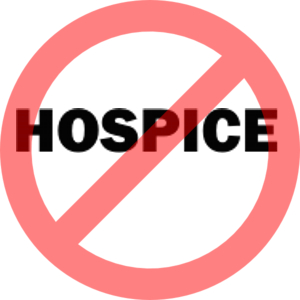Hospice is a great idea. Developed in England over 50 years ago and a part of Medicare for the last 30 years, it has become an  accepted part of end-of-life care. At first hospice was offered through non-profit services and mostly at home. Now a great deal of hospice care is offered by for profit corporations and in long term care facilities. The for-profit hospice services appear to have been “gaming the Medicare system” to maximize profits. The development of for profit businesses that exist to exploit aspects of Medicare and other insurance has a long history; remember in-patient youth psychiatric facilities in the 80’s and early 90’s? (Baughman, 1998; Gale Group, 2011)
accepted part of end-of-life care. At first hospice was offered through non-profit services and mostly at home. Now a great deal of hospice care is offered by for profit corporations and in long term care facilities. The for-profit hospice services appear to have been “gaming the Medicare system” to maximize profits. The development of for profit businesses that exist to exploit aspects of Medicare and other insurance has a long history; remember in-patient youth psychiatric facilities in the 80’s and early 90’s? (Baughman, 1998; Gale Group, 2011)
Kenen (2011) discusses how the Department of Health and Human Services is seeking to cut back Medicare payments for hospice services. Hospice has grown into big business. Kenen states, “According to a June 2011 MedPAC report, the number of people getting Medicare hospice care doubled from 2000 to 2009, to more than 1 million, or about 40 percent of deaths. Total payments quadrupled, from less than $3 billion in 2000 to $12 billion in 2009. … Now, about half of hospices are for profit. Some are small, locally owned businesses, but much of the recent growth has been in big, publicly traded national chains, one of which is owned by the company once known as Roto-Rooter.”
Several strategies for reducing the costs have been suggested. Kenen says, “In 2009, MedPAC recommended that Congress scrap the standard payment rate, now about $151 per day, and replace it with a ‘U’ shaped scale. Hospices would get paid more at the beginning and at the end, when they typically provide the most hands-on care. In between, the daily rate would drop. Any hospice with a very high rate of long-stay patients would face additional regulatory scrutiny. A second approach, included in a recent MedPAC blueprint for offsetting Medicare doctor fees, would be to pay hospices a lower rate for nursing home care — 6 percent less, or about $3 billion in reductions over 10 years.”
Frankly these suggestions are rearranging the deck chairs on the Titanic. Health care policy in the US is rife with micro-management of services and costs that simply rearranges the status quo.
Why not rethink the whole thing? Go back to the beginning. Hospice was developed to meet a need in end-of-life care to back off from intensive interventions and to allow the dying person to approach death in a mindful and pain free manner. Was not the intent that hospice as a model for end-of-life care should become the regular and customary way any health care system helps dying people? In other words, get rid of hospice as an entity and simply make these well proved methods regular practice. All dying people would receive palliative care appropriate to their needs and their care providers would know how this was done and arrange for it.
By eliminating hospice as a specialized service and by stopping specific payments for providing it, we eliminate those niche for profit businesses that exploit Medicare. Hospice becomes not a “special activity” but a routine part of a person’s life. Seems simpler somehow. What’s wrong with this idea?
——————————————————————————————–
Baughman, Fred A. The Fraud of ADHD – Psychiatric History Repeating Itself. February 13, 1998. http://www.psychbusters.net/index.php?option=com_content&task=view&id=16&Itemid=28
The Gale Group, Inc. Psychiatric Hospitals: Industry Report. 2011. http://business.highbeam.com/industry-reports/business/psychiatric-hospitals
Kenen, Joanne. Medicare eyes hospice savings. October 17, 2011. http://www.politico.com/news/stories/1011/66177.html
Leave a comment